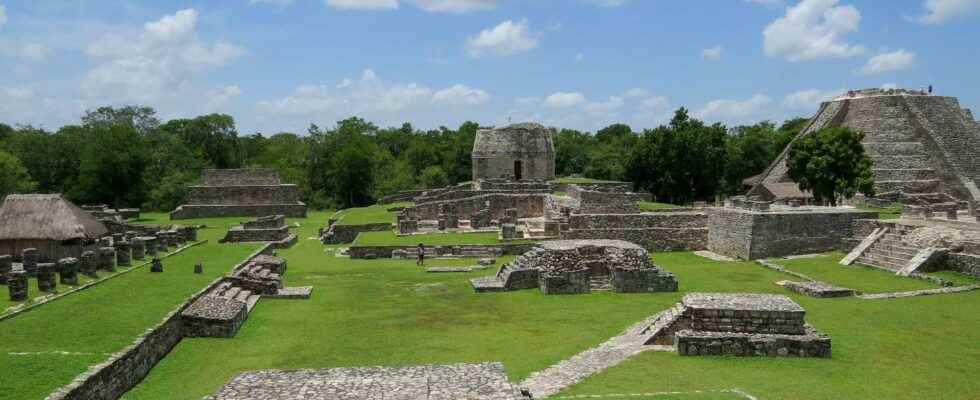You will also be interested
[EN VIDÉO] The secrets of the Mayan calendars The Maya had several calendars, including a sacred one called Tzolk’in.
Founded in 1050, the city Mayapán, which literally means “flag of the Mayas”, was the capital of mayan people for just over two decades. But an episode of drought intense will get the better of this huge city, an episode analyzed by researchers in an open-access study published in the journal type communications. Their goal: to study the consequences of climate change on a human population. For this, they focused on peninsula of Yucatán, in the south-east of Mexico, and the cataclysm which took place there in the XVe century. It housed for about four centuries the Mayan population of the post-classic period, that is to say from 900 until the arrival of the Spaniards in the 16th century.e century.
But, in the fifteenthe century, the distribution of mayan people began to change: the inhabitants scattered from the capital to less populated regions, and the capital was gradually deserted. A phenomenon caused, according to the researchers, by a climatic disturbance in Yucatán, which then generated a succession of consequences leading to a collapse from the city. To make sure, they used a “a transdisciplinary approach that combines archaeological, historical and paleoclimatic datasets to examine the dynamic interactions of climate changecivil strife and political collapse in Mayapán during the XIVe and XVe centuries of our era. »
A real chain reaction
Thanks to the data, samples and bones collected directly on the spot then analyzed and dated, the researchers managed to trace the end of the history of Mayapán. They noted a decline in the population from 1350, while it has been increasing until now, with a lowest level in 1450. At the same time, episodes of drought were listed: “We find a significant relationship between drought and population decline when we look at the period between 1350 and 1430, which is when the greatest population decline occurred”write the researchers.
These lacks of water then created like a chain reaction, described in the study: “Prolonged dry spells during the colonial period caused well-documented crop failures, severe famines, and high mortality that destabilized the economy and led to the periodic dispersal of populations from northern Yucatán towns.”
In addition to the phenomenon of rural exodus, Drought also caused an aggravation of political conflicts already present, between the various wealthy families who dominated the city. The mass graves excavated at the bottom of the city’s emblematic main temple also contained several people belonging to the family of the heads of state, the Cocom, suggesting a rivalry which materialized in civil conflicts during the gradual dissolution of the city. .
A picture of what awaits us in the future?
Finally, this study also focuses on the resilience of the mayan people in the face of climatic and environmental hazards. Because, as the researchers explain, economic, social and religious traditions persisted until the beginning of Spanish rule, despite the reduced scale of political units, attesting to a system resilient human-environment adaptations. They cite in particular the mobility of the inhabitants, which has enabled them to disperse, and therefore to have agricultural needs that are also dispersed. “Archaeological and historical records are well suited to examine the past societal effects of climate crises over long-term cycles”write the researchers.
But if the adaptation of the Maya people to droughts is an example of climate resilience, what lies ahead promises even more difficulties. First, because the changes occur on a much larger scale, and because they are more permanent than in the case of long periods of drought. Researchers are concerned about this because “Current and future anthropogenic influences are expected to amplify the severity of extreme events in the water cycle and lead to more intense and prolonged droughts than those that have impacted agricultural productivity in the past.” They conclude with the current situation in Mexico and Central America, where drought is already a concern and is creating food insecurity, which in turn is leading to “social unrest and migration”. And their fears can be projected to other regions of the world, such as in Europe where many records of drought and heat were beaten this summer 2022.
A desire to escape for the summer?
To celebrate the holidays as it should be, discover the Mag Futura at the preferential price of €15 instead of €19, i.e. a reduction of 20% !
On the program of this issue: a dive into the heart of 4 scientific themes that will mark 2022, from the Earth to the Moon:
- What mysteries does the Moon still hide from us?
- Will we soon be able to cure everything thanks to genes?
- How to feed the world without destroying it?
- Can artificial intelligence become truly intelligent?
What is Mag Futura?
- Our first paper journal of more than 200 pages to make science accessible to as many people as possible
- 4 major scientific questions for 2022, from the Earth to the Moon
- Home delivery*
*Delivery is made in France (excluding metropolitan France), Switzerland, Belgium.
Interested in what you just read?
